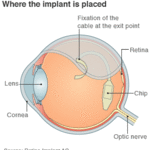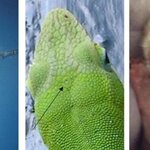Vision

A man with an inherited form of blindness, retinitis pigmentosa, has been able to identify a coffee mug and various shades of gray using a retina implant, according to work published in Proceedings of the Royal Society B.
The Retina Implant AG is a sub-retinal chip placed in the central macular area behind the retina. Their chip works by converting light that enters the eye into electrical impulses which get fed into the optic nerve behind the eye. It requires an external battery which was connected to a cable that protruded from the skin behind the ear.
It's not…

Boise State University's football team is smoking, and some have wondered whether their blue football field may help explain their success...so much so that, a couple months back, Oregon State painted their practice field blue to help them prepare for playing on it.
Could practicing and playing on blue really give the Broncos a leg up? It seems unlikely.
But it seems less unlikely than it would have a decade or two ago. Not because the Boise football team is doing well -- there are plenty of years when the blue field didn't give them the magic -- but because of the many studies showing the…

You’ve heard that space is curved – that’s gravity. You’ve also been told that you cannot really understand curved space. Sure, you can come to know curvy mathematics by studying general relativity or differential geometry, but you cannot grasp curved space in your bones…for the obvious reason that, in our everyday human-level world, space is flat, and so we have a brain for thinking flat. Or, at least, that’s what they say. But there is at least one variety of curvy mathematics that your brain comprehends so completely that you don’t even know you know it. It concerns your visual field, and…

Here’s my vote for the best illusion ever. It was created by B. Pinna, G.J. Brelstaff / Vision Research 40 (2000) 2091–2096.
Loom your head toward, and away, from the center point. Print it out and bring to a bar, and it is even more impressive -- the paper appears to be twisting in your hands.
Some other time I'll tell you my speculation for why it works. (It is a perceiving-the-present explanation.)
-----
Mark Changizi is Director of Human Cognition at 2AI, and the author of books such as The Vision Revolution (Benbella, 2009) and Harnessed: How Language and Music Mimicked Nature and…

Science can make you a better dancer - or at least improve your chances of not looking stupid to the opposite sex, say a group of evolutionary psychologists who used 3D motion-capture technology to create uniform avatar figures and identified the key movement areas of the male dancer’s body that influence female perceptions of whether their dance skills are “good” or “bad”.
Apparently it all comes down to neck, trunk, left shoulder and wrist, the variability of movement size of the neck, trunk and left wrist, and the speed of movement of the right knee.
Sounds simple, right?…

If you're a print magazine, or in marketing consumer goods, you care about packaging.
The general science magazine "New Scientist" approached neuroscience marketing firm NeuroFocus to test three different cover designs for an August issue of the magazine.
Applying their EEG-based full brain measurements of test subjects' subconscious responses to the three covers, NeuroFocus identified one as clearly superior in terms of its overall neurological effectiveness, saying it scored exceptionally well in emotional engagement, one of their primary metrics, the others being attention and memory…

There aren’t many cyclopses in nature, and those that exist don’t live up to expectation. They tend to be crustaceans like water fleas and another aptly named “cyclops” (see left photo below) or early invertebrate fish-like ancestors of ours like lancelets.
Getting these animals tipsy and stabbing them through the eye with a stake turns out to be much less impressive than when Odysseus did it.
For vertebrates we find no cyclopses. On some fish, frogs, lizards and relatives there is a third eye (a “parietal eye”) directly on the tops of their heads (middle photo below), which is cyclops-like…

Can neuroscience help a magazine sell more copies? New Scientist wants to find out, so they teamed up with NeuroFocus, who bill themselves the world's largest neuromarketing company, to make a magazine cover.
Using high density arrays of electroencephalographic (EEG) sensors to capture test subjects' brainwave activity, NeuroFocus measured and analyzed their responses to three different cover designs for the August 7 edition of New Scientist.
By monitoring brainwave activity across the full brain as subjects viewed each of the covers, and using eye-tracking technology to…

"All Americans look alike" is a common joke in Asia and a similar sentiment is expressed in virtually every other country populated by a race different than its tourists. And to some degree it is true. Most people find it much harder to recognize faces of people from different races than their own.
During a 15-month research project funded by the Economic and Social Research Council (ESRC), Teesside University academic Dr. Kazuyo Nakabayashi will carry out experiments in Japan and the UK and collate behavioral and eye movement data.
The study will involve asking students…

I believe that music sounds like people, moving. Yes, the idea may sound a bit crazy, but it’s an old idea, much discussed in the 20th century, and going all the way back to the Greeks. There are lots of things going for the theory, including that it helps us explain (1) why our brains are so good at absorbing music (…because we evolved to possess human-movement-detecting auditory mechanisms), (2) why music emotionally moves us (…because human movement is often expressive of the mover’s mood or state), and (3) why music gets us moving (…because we’re a social species prone to social contagion…